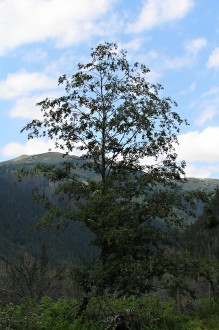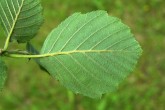(Alnus incana (L.) Moench)
Habitus
- it is a shrub to tree 10 – 20 m high, crown ovate, pointed
- the bark is grayish-brown, later light gray smooth and remains so even to old age!
Buds
- they are built in a spiral, ovate, blunt-pointed, petiolate, the petioles are shorter than those of sticky alder (Alnus glutinosa)
- covering scales two, reddish-brown, slightly tomentose !
Shoots
- they are rounded to bluntly triangular, reddish-brown
- slightly grey-tomentose, later glabrous with white lenticels
Leaves (assimilation organs)
- they are simple, 4 - 10 x 3 - 7 cm large, ovoid to oblong-ovate
- pointed at the end, broadly wedge-shaped at the base
- double-serrated along the edge (shallow-lobed toothed)
- older leaves are dark green on the upper side, greyish-green on the reverse, hairy
- young leaves are grey-tomentose on both sides
Flowers
- it is a monoecious woody plant, flowers of different sexes (morphologically similar to sticky alder)
- both male and female catkins are established in autumn
- it blooms in III - IV, before leaf development (two weeks before sticky alder)
- cones are ellipsoidal, about 1 cm long, on short petioles to sessile
Fruits – seeds
- the fruit is a light brown, inverted ovoid achene, 3 mm in size with a narrow double-sided leathery wing
Extension
- in a large Euro-Siberian area with two centers of occurrence:
- northern Europe and Siberia
- mountainous areas of Central Europe
- it does not occur in the British Isles and in the western part of Europe with a more pronounced oceanic climate
- in Slovakia, it rises up to 940 (1290) m above the sea level, especially in mountain valleys and around streams
Ecology
- it is a light-loving woody plant of continental climate resistant to frost
- it has medium requirements for nutrient content and soil moisture
- it grows mainly along watercourses in the mountains and in squirt
- it forms homogeneous (along watercourses), but also mixed stands with sticky alder (Alnus glutinosa), species of the genus birch (Betula), Norway spruce (Picea abies), species of the genus willow (Salix) and other woody plants
Significance
- it is a pioneering, ameliorative, banks strengthening and preparatory woody plant
- its various forms are also used in greening
- wood is like sticky alder, but of slightly worse quality and does not even reach such dimensions






















